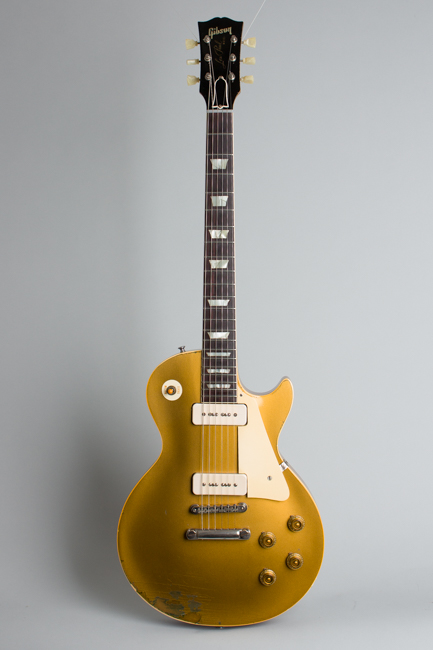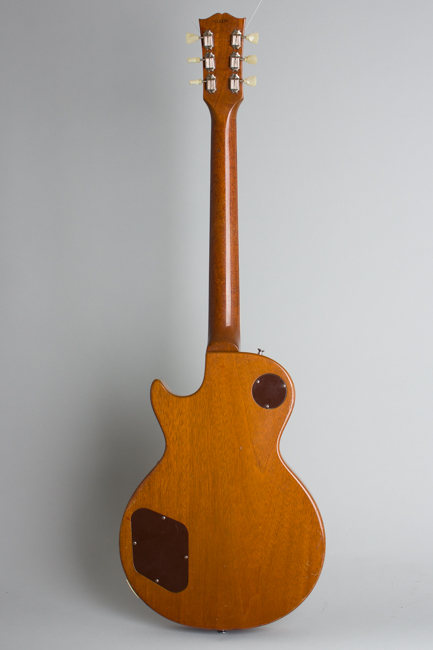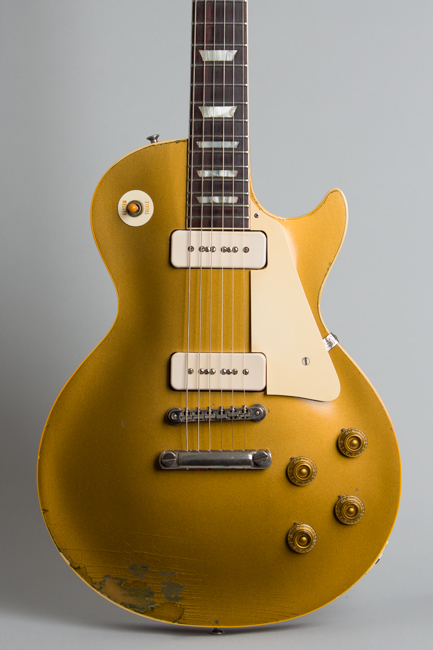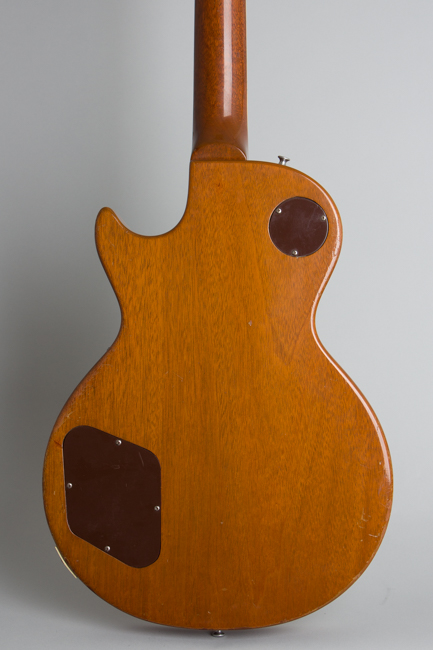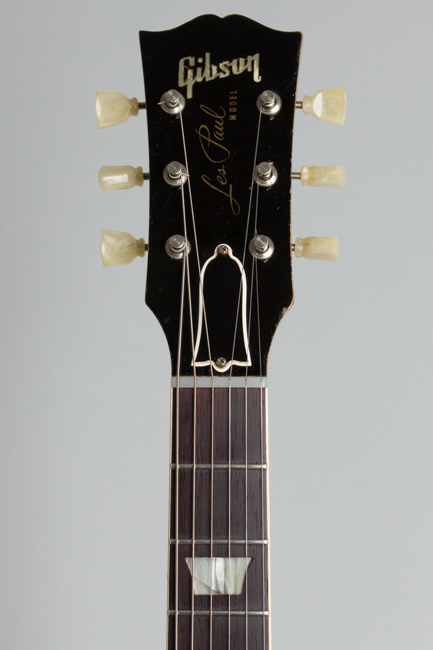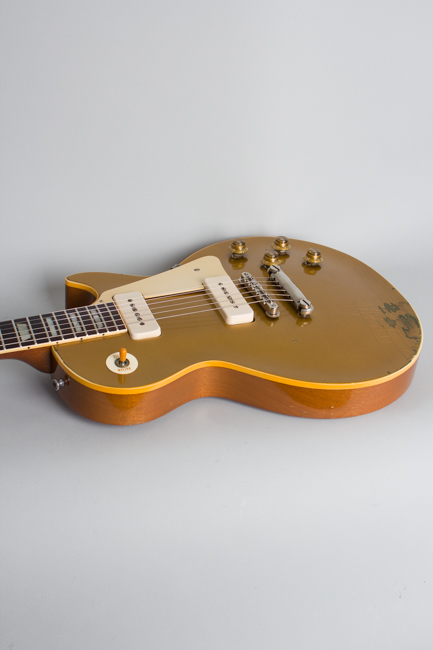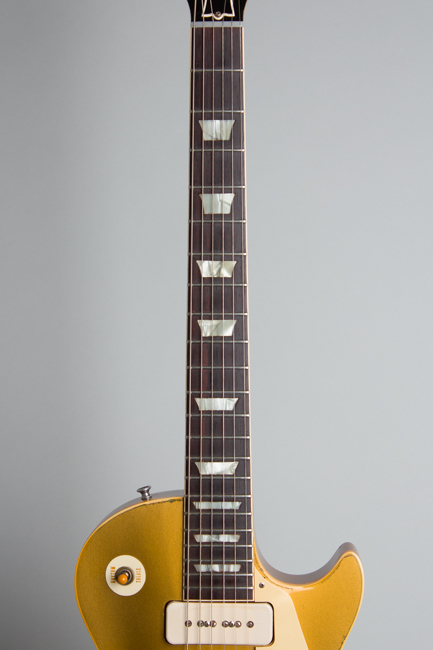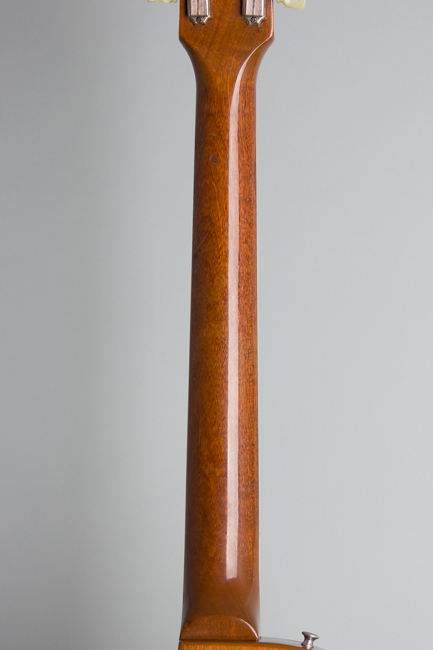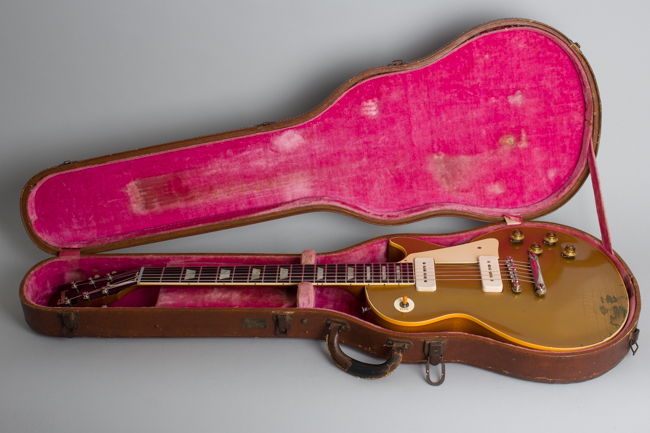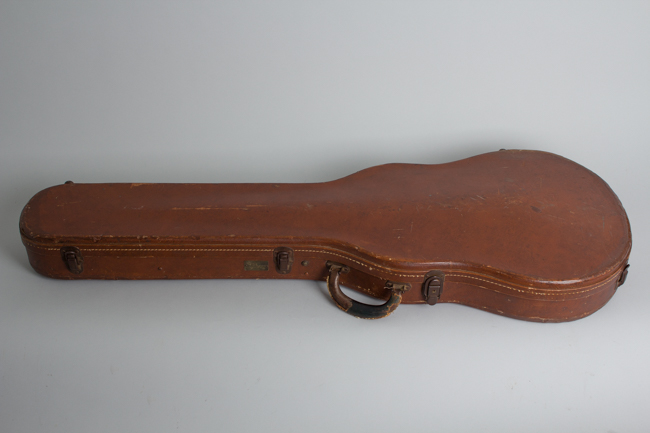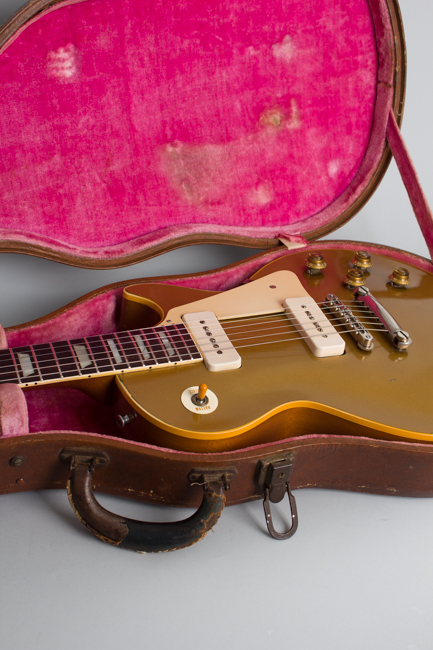Gibson Les Paul Model Solid Body Electric Guitar (1955)
This item has been sold.
Item # 10574
Prices subject to change without notice.
Gibson Les Paul Model Model Solid Body Electric Guitar (1955), made in Kalamazoo, Michigan, serial # 513259, gold lacquer top, natural back and sides finish, mahogany body with maple cap, mahogany neck with rosewood fingerboard, original brown hard shell case.
This is a very cool example of one of Gibson's most important guitars-the original gold-topped Les Paul Model. It dates to very late 1955 and represents the third major variation of this all-time classic, with the then-new more player-friendly Tune-O-Matic bridge and stop tailpiece set up. This replaced the less intonatable solid "stud" bridge/tailpiece that in turn was a fix for the earlier "Les Paul" trapeze unit the model was introduced with. Les Paul himself was very unhappy with the initial models, constructed so the strings wrapped UNDER the bar of the trapeze unit instead of over as intended. Gibson president Ted McCarty personally designed the Tune-O-Matic bridge with adjustable saddles; it was first used on the upscale Les Paul Custom and migrated to this "Standard" model in late '55/early '56.
Besides being one of the first with the new bridge other features of this 1955-6 Les Paul Model include the bound rosewood fingerboard with pearloid trapezoid inlays, twin single-coil P-90 pickups under cream plastic covers with center-mount screws and Kluson Deluxe tuners with keystone-shaped buttons. In an idiosyncratic touch, the pearl Gibson logo is set lower down on the headstock than late '50s models. The back and sides are finished in natural and the top is gleaming gold, as it had been since 1952.
This guitar represents the final and most player-friendly iteration of P-90-equpped Les Pauls, especially compared to the first model with the strings mounted under the trapeze bar. Less than two years after this guitar was built the Les Paul model was upgraded with the new humbucking pickups, making the production run for this version was fairly short. Longtime Gibson historian Andre Duchossoir estimated only perhaps a thousand or so of these P-90 and Tune-O-Matic goldtops were made from late 1955 through mid 1957. The original list price was $250 in late 1955, plus another $43 for the case.
This is a fine example of these revolutionary guitars which established the Les Paul as the "other" prime contender in the solidbody market and Fender's greatest competition. The first solid-bodies with the class of a Gibson, these guitars convinced many players to lay down their electrified arch-tops and enter the new world of higher volume. The Les Paul line included the upscale Custom, down-market Special and Junior but this is the model that started it all. To this day many players feel these 1955-57 Tune-O-Matic/P-90 Les Pauls are as fine a solidbody guitar as has ever been made.
Overall length is 39 in. (99.1 cm.), 13 in. (33 cm.) wide at lower bout, and 1 15/16 in. (4.9 cm.) in depth, measured at side of rim. Scale length is 24 3/4 in. (629 mm.). Width of nut is 1 11/16 in. (43 mm.).
This 67 year old Les Paul remains a nice original example, played but not too heavily worn, showing some work done over the years but nothing that detracts from its sound or character. While it is not a super clean or absolutely original instrument it remains in better condition than many of these often heavily used guitars.
The signature gold top shows some typical wear, and the results of some old attempts to mitigate the gold lacquer's tendency to "green" and flake when played. The entire top appears to have an old overspray, likely added in an effort to stabilize the finish decades ago. There are some larger areas flaked away on the upper/rear edge from arm contact, mostly down to the undercoat. In a couple of spots these flaked-off areas have been subsequently filled in, but that attempt was apparently abandoned after a few were complete. There are some greening/checking lines coming off this area, but the rest of the top remains relatively clean.
The back of the neck also has what appears to be an old and very light clear overspray, subsequently worn through in places. It shows minor dings and dents and some finish worn off the edges in the lower positions. The rest of the instrument's finish is comparatively clean and shows very light checking with minor dings, dents and scrapes overall but no other heavily worn areas.
Internally the wiring is original and unaltered except the original masking tape has been replaced on neck pickup leads with black electrical tape, also probably a long time ago. The original tape is intact on bridge pickup. All pots, the coveted bumblebee caps and the adjoining solder joints are original and unaltered. The jack plate is the original cream plastic style but appears later, with a small crack off the centerline; another older-looking plate is stored in the case pocket.
All other hardware is original and complete. The neck pickup cover has a strake of wear into the plastic the area just below the fingerboard, possible related to an errant tool during the refret. The Tune-O-Matic bridge and lightweight stop tailpiece are original and relatively clean without much plating wear. The pickguard is original, there is some corrosion on the upper part of the bracket.
The replaced frets are larger than the 1950's Gibson spec, much more to the rock player/string bending taste but not the extreme oversize '80s style. The rosewood fingerboard has been trued and shows little to no subsequent wear. The nut was replaced as well.
The guitar is very playable with a really superb and very powerful sound on both pickups, which are mounted very close under the strings. When all-time classic solidbodies are discussed, these gold top 1957-76 Les Pauls with the Tune-O-Matic/P-90 layout are always in the mix. This is the model Gibson re-issued first in 1968, at which time most users were actually looking for humbucker-equipped Standards. With another 50+ years of hindsight the single-coil but meaty sounding P-90 pickups have more than proven their worth and a number of players now actually prefer their distinctive sonic signature. This splendid survivor is still housed in its original pink-lined, four latch Lifton brown case. Overall Excellent - Condition.
This is a very cool example of one of Gibson's most important guitars-the original gold-topped Les Paul Model. It dates to very late 1955 and represents the third major variation of this all-time classic, with the then-new more player-friendly Tune-O-Matic bridge and stop tailpiece set up. This replaced the less intonatable solid "stud" bridge/tailpiece that in turn was a fix for the earlier "Les Paul" trapeze unit the model was introduced with. Les Paul himself was very unhappy with the initial models, constructed so the strings wrapped UNDER the bar of the trapeze unit instead of over as intended. Gibson president Ted McCarty personally designed the Tune-O-Matic bridge with adjustable saddles; it was first used on the upscale Les Paul Custom and migrated to this "Standard" model in late '55/early '56.
Besides being one of the first with the new bridge other features of this 1955-6 Les Paul Model include the bound rosewood fingerboard with pearloid trapezoid inlays, twin single-coil P-90 pickups under cream plastic covers with center-mount screws and Kluson Deluxe tuners with keystone-shaped buttons. In an idiosyncratic touch, the pearl Gibson logo is set lower down on the headstock than late '50s models. The back and sides are finished in natural and the top is gleaming gold, as it had been since 1952.
This guitar represents the final and most player-friendly iteration of P-90-equpped Les Pauls, especially compared to the first model with the strings mounted under the trapeze bar. Less than two years after this guitar was built the Les Paul model was upgraded with the new humbucking pickups, making the production run for this version was fairly short. Longtime Gibson historian Andre Duchossoir estimated only perhaps a thousand or so of these P-90 and Tune-O-Matic goldtops were made from late 1955 through mid 1957. The original list price was $250 in late 1955, plus another $43 for the case.
This is a fine example of these revolutionary guitars which established the Les Paul as the "other" prime contender in the solidbody market and Fender's greatest competition. The first solid-bodies with the class of a Gibson, these guitars convinced many players to lay down their electrified arch-tops and enter the new world of higher volume. The Les Paul line included the upscale Custom, down-market Special and Junior but this is the model that started it all. To this day many players feel these 1955-57 Tune-O-Matic/P-90 Les Pauls are as fine a solidbody guitar as has ever been made.
Overall length is 39 in. (99.1 cm.), 13 in. (33 cm.) wide at lower bout, and 1 15/16 in. (4.9 cm.) in depth, measured at side of rim. Scale length is 24 3/4 in. (629 mm.). Width of nut is 1 11/16 in. (43 mm.).
This 67 year old Les Paul remains a nice original example, played but not too heavily worn, showing some work done over the years but nothing that detracts from its sound or character. While it is not a super clean or absolutely original instrument it remains in better condition than many of these often heavily used guitars.
The signature gold top shows some typical wear, and the results of some old attempts to mitigate the gold lacquer's tendency to "green" and flake when played. The entire top appears to have an old overspray, likely added in an effort to stabilize the finish decades ago. There are some larger areas flaked away on the upper/rear edge from arm contact, mostly down to the undercoat. In a couple of spots these flaked-off areas have been subsequently filled in, but that attempt was apparently abandoned after a few were complete. There are some greening/checking lines coming off this area, but the rest of the top remains relatively clean.
The back of the neck also has what appears to be an old and very light clear overspray, subsequently worn through in places. It shows minor dings and dents and some finish worn off the edges in the lower positions. The rest of the instrument's finish is comparatively clean and shows very light checking with minor dings, dents and scrapes overall but no other heavily worn areas.
Internally the wiring is original and unaltered except the original masking tape has been replaced on neck pickup leads with black electrical tape, also probably a long time ago. The original tape is intact on bridge pickup. All pots, the coveted bumblebee caps and the adjoining solder joints are original and unaltered. The jack plate is the original cream plastic style but appears later, with a small crack off the centerline; another older-looking plate is stored in the case pocket.
All other hardware is original and complete. The neck pickup cover has a strake of wear into the plastic the area just below the fingerboard, possible related to an errant tool during the refret. The Tune-O-Matic bridge and lightweight stop tailpiece are original and relatively clean without much plating wear. The pickguard is original, there is some corrosion on the upper part of the bracket.
The replaced frets are larger than the 1950's Gibson spec, much more to the rock player/string bending taste but not the extreme oversize '80s style. The rosewood fingerboard has been trued and shows little to no subsequent wear. The nut was replaced as well.
The guitar is very playable with a really superb and very powerful sound on both pickups, which are mounted very close under the strings. When all-time classic solidbodies are discussed, these gold top 1957-76 Les Pauls with the Tune-O-Matic/P-90 layout are always in the mix. This is the model Gibson re-issued first in 1968, at which time most users were actually looking for humbucker-equipped Standards. With another 50+ years of hindsight the single-coil but meaty sounding P-90 pickups have more than proven their worth and a number of players now actually prefer their distinctive sonic signature. This splendid survivor is still housed in its original pink-lined, four latch Lifton brown case. Overall Excellent - Condition.
